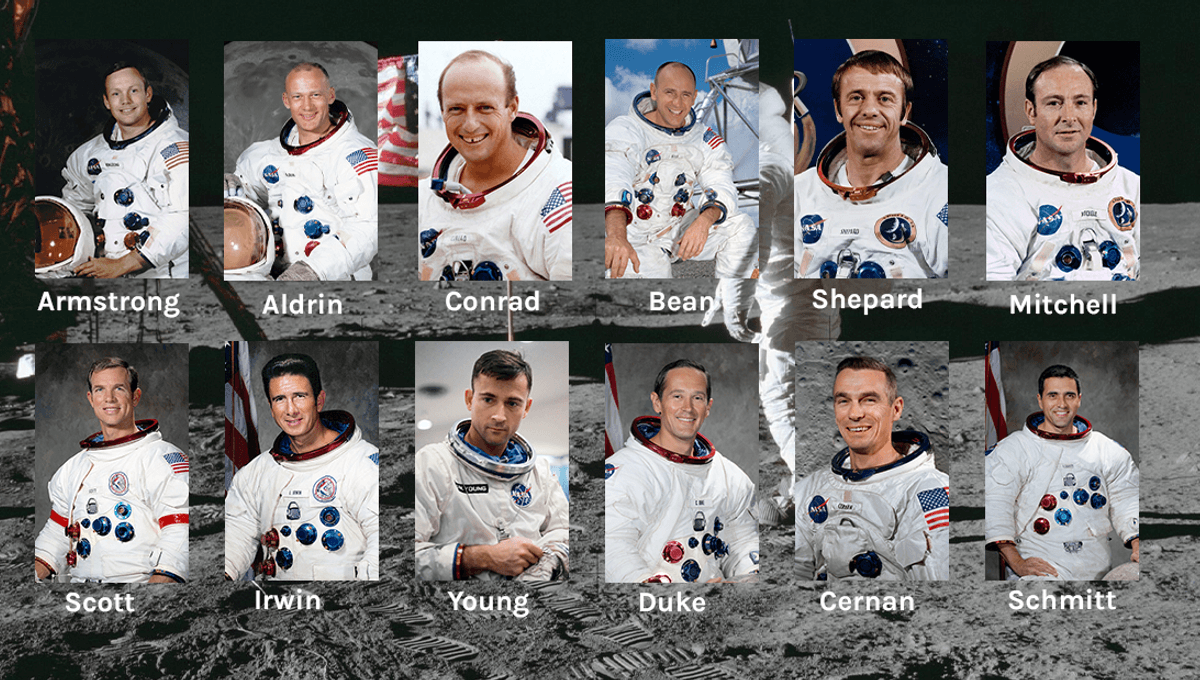
Sometimes conspiracy theorists believe they have a “gotcha” that blows apart a whole concept – apart from the fact that the most basic of searches will prove them wrong. We recently covered the unveiling of the new spacesuit that will be donned by the astronauts who will go back to the Moon in a few years. In response to that piece, we got this reply: “If the Moon landing was real, why did we never go back?” This was puzzling at first… because we went back five more times.
The Apollo program was a huge success, but it was also very expensive and fraught with risk. But it did land 12 men on the surface of the Moon. The first two were, of course, Neil Armstrong and Buzz Aldrin with Apollo 11 on July 20, 1969. And here is a little spotlight on the rest.
Apollo 12
Just four months after Apollo 11, its successor landed on the Moon in the Ocean of Storms – Oceanus Procellarum. Charles “Pete” Conrad and Alan Bean touched down on the lunar surface on November 19, 1969. This mission landed within walking distance of the robotic craft Surveyor 3. Conrad and Bean actually brought parts of Surveyor 3 back to Earth. On the whimsical side, Apollo 12 is the first recorded use of hammocks on another world, as they were used by the two to sleep more comfortably.
Apollo 14
Apollo 13 suffered a major malfunction on its way to the Moon, so its Moon landing was canceled. The third time humanity got to our natural satellite was on February 5, 1971. Alan Shepard – the first American to travel into space – and Edgar Mitchell become the fifth and sixth people to walk on the Moon. Apollo 14 also suffered some malfunctions but nothing too serious, although there was a concern that a second aborted mission might mean the end of the Apollo Program. The mission’s most famous event fortunately became Shepard hitting two golf balls, not some accident. As it stands, he’s the oldest person to have been on the Moon, aged 47.
Apollo 15
David Scott and James Irwin landed on the Moon on July 30, 1971. NASA was already expecting budget cuts, so there were modifications to the mission to get the most out of the Moon – including the first use of the Lunar Roving Vehicle, the first human driving beyond Earth. Scott performed the famous Galileo experiment that shows that objects fall to the ground with the same acceleration regardless of mass. He did that by dropping a feather and a hammer.
The mission also had a record with Alfred Worden, who did not land on the Moon but performed an EVA (extravehicular activity) to retrieve film cassettes from the two Moon-mapping cameras on the outside of the module while the capsule was 321,869 kilometers (200,000 miles) from Earth. This mission held the record for the largest number of people exposed to the vacuum of space at the same time, until the Polaris Dawn mission private space walk of last month.
Apollo 16
John Young and Charles Duke landed on the Moon on April 21, 1972. The pair spent almost three days on the Moon, collecting material including the largest rock ever brought back from the Moon by Apollo: Big Muley. The rock was 11.7 kilograms (25.8 pounds). The lunar lander was called Orion to connect it with one of the brightest constellations in the sky. Command module pilot Thomas Mattingly instead chose the name Casper for the command and service module because, “There are enough serious things in this flight, so I picked a non-serious name,” as reported in The New York Times.
Apollo 17
Eugene Cernan and Harrison Schmitt became the last astronauts – for now – to have walked on the Moon. They landed on December 11, 1972. NASA wanted to end on a high and Apollo 17 was a longer crewed lunar landing mission – the one where astronauts went the furthest away from their spacecraft, spent the longest on the Moon both in and out of the craft, and brought the largest amount of lunar rocks to Earth. It was also the first one that had a scientist, Schmitt. Schmitt has another primacy: he’s the first person to be allergic to Moon dust. Despite the many records, there was little TV coverage of the mission. After six times, Moon landings were becoming routine and not primetime events.
What’s next?
There is no possible way that the Moon landings were faked. Or maybe we should believe the joke that they were directed by Stanley Kubrick, but he was such a perfectionist that he wanted to shoot them on location.
For sure the conspiracy theorists will find something to complain about with the Artemis program, but for those of us who care about facts and space, we are looking at some exciting years ahead. The Artemis program will bring humans back to the Moon and will mark the landing of the first woman, the first person of color, and the first non-US citizen on the lunar surface. Artemis III, currently scheduled for 2026 (but there might be delays), will be the first of several planned lunar landings.
Source Link: How Many People Have Walked On The Moon? It's A Lot More Than Two